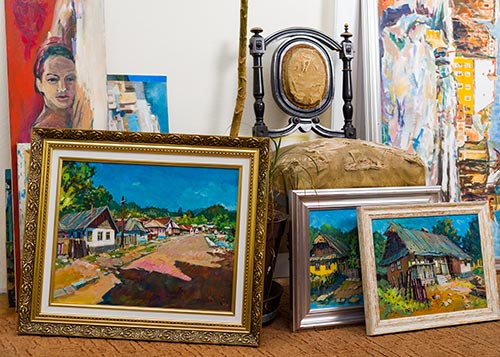Once you’re in a high value property, the odds are high you’re going to want to put your personal stamp on it. For most people, this is going to include a couple of art pieces, perhaps paintings or antiques.
The problem with art is that it’s highly subjective. What one person loves, another would quietly place on a burn pile. For investment pieces, you need to know what the art market is trending towards, and pick something you can live with, unless you plan on placing it in a vault and ignoring it for the next twenty years.
Art as an investment piece can be broken down into either guaranteed or potential investments.
Buying from completely unknown artists is a gamble, especially if you don’t have much knowledge in the field.
Do you take a chance on buying from new or unknown artists in the hope that their work becomes acclaimed in the future, or will you end up with something that will end up in the local charity shop?
There are a lot of decently talented artists who never get much recognition past the local flea market, and there are some very bad artists who get fifteen minutes of fame and end up with works that cost a small fortune because they understand the market trends.
The odds are high that, unless you have a great eye, understand what drives the art market, or have an expert that you can rely (preferably all of the above, although you should aim for at least two of those), you are going to end up with fruit study of distorted apples that gets shuffled quietly out to the shed down the line.
Saying that, buying from new artists just beginning to make a name for themselves can be an excellent investment. You’ll want to pick someone that is starting to get some name recognition with collectors and dealers but hasn’t reached the pinnacle of fame just yet.
A guaranteed art investment is going to be one of the masters. If you have the means to invest in a Mondrian or a Hockney, do so. The giants of the art world will only increase in value over time.
Don’t restrict yourself to paintings or limited edition prints either. There are some phenomenal glass, ceramic and textile artists that are worth collecting, and these pieces can go in areas where a painting cannot.
Pieces by Thomas Stearns will cause a stampede when his works come up for auction, and 2018 saw an eighteenth-century Chinese vase sell at auction for a rather juicy $41.6m.

Looking after your art investment is important.
Keep paintings out of direct sunlight and away from smoke, and do not place a print or painting in a bathroom or kitchen unless you hate it and want to see if mildew improves the appearance.
Yes, I scream at design TV programmes on a frequent basis. It might make for good television, but it’s a terrible thing to do to a perfectly nice painting.
Even poster prints behind glass will mildew if you hang them in the bathroom, and so will most textiles.
If you absolutely must have an art piece in the loo, choose glass or ceramic pieces and display them out of easy grabbing or bumping reach. Remember they’ll still need a dust and wipe down from moisture accumulation, so make sure they’re actually accessible.
Do not place oil paintings under glass. Watercolours and acrylics evaporate, while oil paints oxidise, which means they need air contact.
Even surface-dry oil paintings can take years to fully dry out and placing glass over the surface means that you’ll have half the painting stuck to the glass when you try to remove it. A good sealant, which the artist will apply, means no glass is needed, whether it’s on canvas, board or panel.
If your oil painting is discoloured or damaged, do not try to clean it yourself. This is a specialist job, and art restoration is a highly skilled occupation. It’s worth taking it to someone who knows what they’re doing and won’t ruin your investment piece.
Your art pieces, chosed wisely and looked after properly, will last for years, making them long-term investments and inheritance objects that your family can cherish for decades to come.
And finally - don't forget your home insurance
Don’t forget to check your fine art, antiques and valuables home insurance policy to make sure your artwork is properly covered and for the correct sums insured
Need a good high value home contents insurance broker? We’ve got you covered – click here to fill out a short form and we’ll pass your details onto our list of brokers.